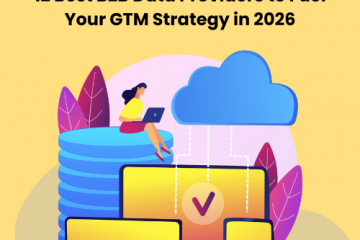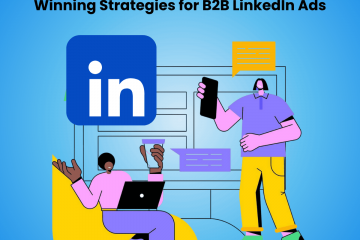Here’s Your Demand Generation Framework For 2025
A demand generation framework forms the backbone of effective marketing strategies, serving as a crucial precursor to lead generation. This comprehensive approach focuses on creating awareness and interest in products or services, laying the groundwork for future conversions. While lead generation targets bottom-of-the-funnel activities, demand generation encompasses a broader spectrum of top-of-the-funnel initiatives.
A well-structured demand generation framework is essential for businesses seeking to drive sustainable results. This framework should incorporate several key components to ensure success. Identifying and segmenting the target audience is a critical first step. By creating detailed buyer personas based on demographics, interests, and pain points, companies can tailor their messaging to resonate with specific groups
When people talk about inbound marketing, the two phrases you hear most often are “lead generation” and “demand generation,” often used interchangeably.
Demand generation framework, the strategy to drive demand for your products and services, is usually defined through top-of-the-funnel activities. Lead generation, on the other hand, is a bottom-of-the-funnel activity.
Demand generation is NOT lead generation, and not having a proper lead generation framework means your focus might be on surface-level activities like running ads on gated content or occasionally posting on LinkedIn, without attributing the impact on revenue.
While these activities are important for demand generation, they need to be done systematically to generate sustainable results. In this blog post, we will explore key components of demand generation frameworks and discuss the activities needed for a successful demand generation strategy.

Image Source: Hubspot
What is Demand Generation?
Demand generation is a long-term marketing strategy that aims to drive demand for your products or services by identifying consumer needs, targeting relevant cohorts, and acquiring leads for your business. Simply put, demand generation uses inbound marketing strategies to get people or businesses excited about your products or services.
Demand generation framework encompasses a broad spectrum of activities designed not only to attract potential customers to your brand but also to keep them actively engaged throughout their journey.
Understanding the Difference Between Lead Generation and Demand Generation
“We need more leads!”
“What do we do to get more leads? Generate more demand!”
While these two terms often point to a shared objective—acquiring customers—their roles within the marketing funnel are distinct. Demand generation is actually the precursor to lead generation. It is a top-of-the-funnel strategy focused on creating awareness and sparking interest in your products or services. This is achieved through activities that educate and engage your target audience, helping to establish your brand as a credible and valuable resource.
On the other hand, lead generation comes into play later in the funnel, converting the interest generated by demand generation into actionable leads. This typically involves a sign-up mechanism, such as filling out a form or subscribing to a newsletter, where potential customers express their interest and provide their contact information. While demand generation aims to attract a broad audience, lead generation narrows the focus to those prospects who are ready to move further down the funnel toward a purchase decision.
TL;DR: Demand generation leads to lead generation.
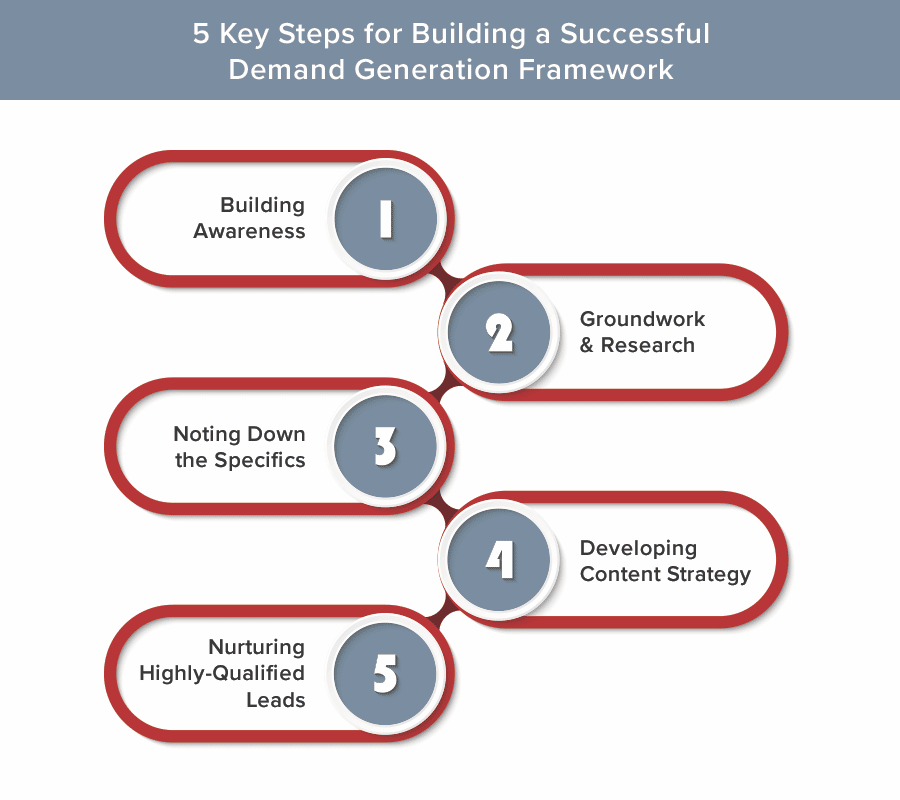
Image Source: Datamatics
What Is a Demand Generation Framework? Why Do I Need One?
The problem with demand generation is that it is often casually replaced with lead generation. If you ask fellow marketers how they plan to generate demand, there is a high chance many would talk about lead generation strategies. Even if the scope of demand generation is clearly understood, the strategies that come to mind for most marketers often revolve around PPC, SEO, social media, etc.
Thinking through and implementing action items is good, but demand generation is an intricate process that requires proper planning and consistency. The scope of demand generation is much wider than just “getting leads”; it is about building authority for your brand, generating trust among your audience, and educating them about your products and services.
In a competitive digital market where your competitors are already appearing in front of your audience, waiting for the lead generation moment is a losing battle. This is why a structured approach is needed.
From identifying target audiences to converting prospects into leads, a structured framework is essential for managing the process from start to finish, ensuring predictability and effectiveness in achieving desired outcomes.
A demand generation framework would help you:
- Systematically scale demand generation efforts as needed.
- Broadcast a consistent message and drive aligned efforts across different channels and sales and marketing departments.
- Adapt to changing marketing conditions when needed and plan for expected shifts.
- Make data-driven decisions that bring qualified prospects to your business.
Simply put, while directly jumping into strategies might work, a proper framework would help you create streamlined efforts to educate your audience long-term and turn them into customers.
Developing a Demand Generation Framework
Now that we understand why a demand generation framework is needed, let’s jump to how we can establish a demand generation framework.
Identify, build, and segment your target audience
You can generate a lot of demand, but it won’t matter if that demand doesn’t convert into revenue. For this reason, identifying your target audience and segmenting them before you start generating demand is crucial.
You need to begin by identifying your audience. This involves creating buyer personas based on different demographics, interests, and pain points. These interests and pain points should connect with the problems your products or services solve. Once the target market is identified, you must build your audience by creating high-value content (as discussed earlier) and engaging with them.
Finally, your task is to segment your audience so you can separate the cream from the milk. Not everyone has buying intent. Additionally, segmenting based on different interests and motivations can help you deliver more relevant and tailored messages to different groups.
Use content as the foundation of your demand generation framework
When you generate leads online through inbound strategies, content has to be the cornerstone of your framework. Especially if you are a B2B business, creating high quality content that generates value for your target audience makes you seen as an authority figure in your industry.
Speaking of content marketing, Justin Rowe (CMO at Impactable), states that “Rather than solely focusing on product features and pricing, there’s a concerted effort to elevate subject matter experts, having them dive deeper into detailed problem-solving processes, sharing insights on the steps taken to address challenges, and providing substantial, meaty content.”
The importance of content formats like blogs, whitepapers, and webinars in building trust and credibility with potential customers is crucial for any demand generation framework.
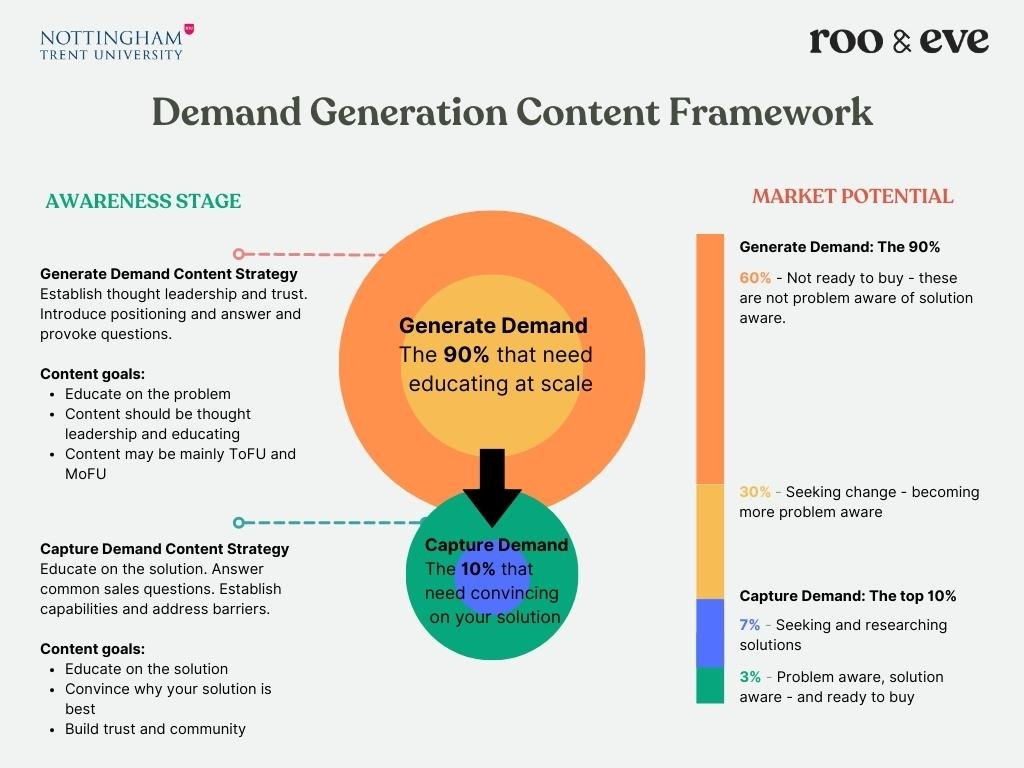
Image Source: Roo & Eve
Choose your channels wisely
Choosing where to generate your demand is mission-critical, as picking the wrong channels could mean attracting traffic that doesn’t convert or, worse, acquiring the wrong type of customers.
For B2B businesses, LinkedIn has become one of the most important networks for generating demand. Adding connections from your target audience, posting high-value thought leadership content, and utilizing LinkedIn ads can all be effective social strategies.
Similarly, Google Search can generate significant demand over a longer period, but its implementation requires patience and resources. Consistently creating content, such as blog posts, helps build a steady viewer base over time, driving demand for your products or services. You can also invest in Google Ads to accelerate this process.
While these platforms aren’t prioritized by many B2B businesses, YouTube, Instagram, and Facebook can also help generate demand, provided your target audience frequents these spaces.
Plan sales-marketing aligned initiatives
In B2B strategies like Account-Based Marketing (ABM), sales and marketing often need to work together to generate demand and convert that demand into revenue. Sales and marketing alignment for demand generation starts with setting common KPIs and targets.
Next, they should collaborate on identifying buyer personas and creating audiences. Marketing teams often have a broad understanding of audiences, while sales teams work directly with prospects. This can lead to misalignment, where the sales team complains about the quality of leads provided by marketing. To avoid this situation and acquire demand from the right cohorts, sales and marketing need to work closely together.
These two teams should also collaborate on content, messaging, and audience nurturing. They can provide each other with reports and brainstorm ideas. Strong alignment between sales and marketing is essential for building an effective demand generation strategy.
Be more specific, work on actionable items while focusing on the bigger picture
This might sound like general advice because it is, but it needs to be emphasized! Often, the idea of demand generation revolves around phrases like “we need to run this campaign” or “we need to post more on this channel.” More often than not, this leads to lead generation strategies, good-to-have outcomes, and not a strong demand generation framework.
A strong demand generation framework requires you to be specific about what you plan to do, how it will generate demand, and, more importantly, whether it will generate demand from the right audience. You also need to work on actionable items without losing sight of how everything connects to the bigger picture.
Set your KPIs and monitor them consistently. There’s no rocket science here—consistent and disciplined efforts often translate to results and can be scaled as needed.
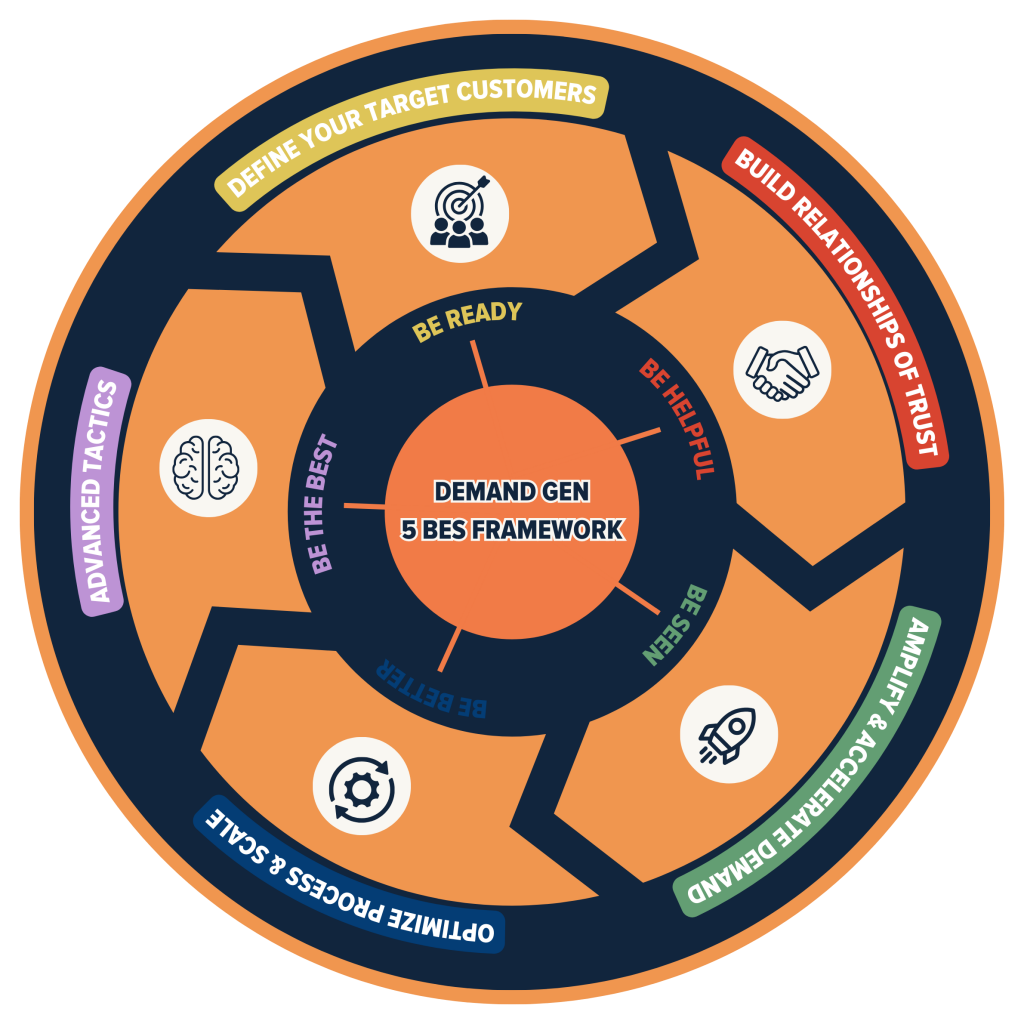
Image Source: The B2B Playbook
Key Activities That Should Be the Part Of Your Demand Generation Framework
Build trust and awareness
Wherever your target audience spends time, it is important for you to show up and build trust and awareness. Do you have something to say that challenges their views? Know something that will capture their attention? Understand how you can solve their pain points?
Spread your message to your target audience through thought-leadership content. You can share in-depth blog posts, work with experts on podcasts, share your views on LinkedIn or YouTube, or collaborate directly with potential customers.
As Andrei Zinkevich from FullFunnel explains it, demand can be generated throug four pillars:
- Content Collaboration: Show up infront of target audience using podcasts, blog articles, guest posts, and webinars.
- Events: Participate in events with industry experts and thought-leaders.
- Social Engagement: Engage with target accounts, influencers, and communities.
- Paid Promotions: Promote your best content to target accounts.
These activities would help you build trust and awareness and stand out as an authority figure in your niche.
Create lots of content
As mentioned earlier, content is the pillar of a successful demand generation framework. You have to create content consistently in different formats. Blog posts, thought-leadership essays, audio content, video content, you name it.
The content you create will help you be discovered by your target audience and educate them. This education would later translate into demand.
You can:
- Create blog posts that rank for keywords your target audience searches for.
- Consistently create content for social channels and build engagement over time.
- Build thought-leadership pieces and show up as an expert.
Distribute your content
Distribution of content is equally important to content creation. If you create the magnum opus but nobody views it, your efforts will go to waste. Identifying key distribution channels will help you generate demand from the right audience.
Here are a few distribution channels you can use:
1. LinkedIn: We have mentioned this earlier as well. Post valuable content and use the right keywords and hashtags to reach your audience. Use individual accounts to connect with decision-makers of target accounts and network with them.
2. Youtube: Create videos on your niche topics, upload podcasts and webinars, and get organic visits from relevant audiences.
3. Google Search: Create blog articles on keywords your audience searches on the web and use SEO practices to rank for these keywords.
4. Newsletters: Once you have built an audience, you can send them newsletter to have them view your latest content.
These are some content distribution channels you can use to get your content viewed by your target audience.
Optimize your lead generation funnel
Your demand generation funnel fails if your target audience does not convert into leads. Optimize your landing pages, lead magnets, and forms to achieve the best conversion rates. You can use CRO software to help with this.
Optimize your funnel with the following:
1. Clarify the value proposition: Make the value proposition obvious and enticing. The value that visitors would get from signing up or subscribing to your content should be obvious.
2. Optimize your Call to Actions (CTAs): Your CTA should be prominently displayed and action-oriented. Use persuasive language that encourages immediate action, such as “Get Started,” “Download Now,” or “Claim Your Free Trial.
3. Optimize your forms: Forms can be tricky. While a shorter sign-up would lead to a lot of unqualified leads, longer complicated forms can tank your conversion rates. It is important to find the right balance and ask the right questions.
Qualify and score leads
Some leads are better than the other. If you are generating a lot of leads from your demand generation efforts, the sales team can’t speak to every one of them. This is why implementing a lead scoring system or a qualification framework can help you identify and prioritize the right customers.
For lead qualification, you can use a tool like Salespanel (shameless plug!). Salespanel tracks the entire customer journey of your prospects and helps you qualify them using profile and behavioral data. The tool can help your sales reps prioritize the best prospects while unqualified leads are either nurtured more or dropped off.
Keep tabs on sales conversations
This is where sales-marketing alignment becomes important again. Engage in active collaboration with the sales team to convert demand into revenue more efficiently.
You can:
- Regularly communicate with the sales team to stay updated on the status of leads and understand their challenges.
- Provide the sales team with data, insights, and tools that enable them to close deals more efficiently.
- Deliver different types of content to prospects at various stages of the sales funnel to keep them engaged and move them closer to conversion.
These activities should be part of your demand generation framework. Use the ones that are best suited for your brand.
Final Thoughts
Building an effective demand generation framework is not just about executing isolated marketing tactics; it’s about creating a cohesive strategy that aligns every aspect of your marketing and sales efforts. A lot can be achieved through discipline and consistent aligned efforts which is why a framework is needed. By consistently refining your strategies and staying aligned with your overarching business goals, your demand generation efforts can become a powerful engine for long-term growth and profitability.
Frequently Asked Questions
What are the essential components of an effective demand generation framework?
An effective demand generation framework typically includes:
• Target audience identification • Multi-channel marketing approach • Compelling content creation • Lead nurturing processes • Marketing automation tools • Performance metrics and analytics • Sales and marketing alignment
These components work together to attract potential customers, generate interest in products or services, and guide prospects through the buying journey.
How does demand generation differ from lead generation?
Demand generation focuses on creating awareness and interest in a company’s products or services among potential customers. Lead generation, on the other hand, aims to capture contact information from interested prospects.
Demand generation is a broader strategy that encompasses lead generation. It involves educating the market, building brand recognition, and fostering long-term relationships with potential customers.
What strategies are commonly employed in demand generation programs?
Common demand generation strategies include:
• Content marketing (blogs, whitepapers, ebooks) • Search engine optimization (SEO) • Social media marketing • Webinars and virtual events • Account-based marketing (ABM) • Paid advertising (PPC, display ads) • Email marketing campaigns • Referral programs
These strategies aim to attract, engage, and nurture potential customers throughout their buying journey.
Can you outline the six steps typically involved in the demand generation process?
- Identify target audience and buyer personas
- Develop valuable, relevant content
- Implement multi-channel marketing campaigns
- Capture and qualify leads
- Nurture leads through personalized communication
- Analyze results and optimize strategies
This process helps businesses create a systematic approach to generating and maintaining interest in their products or services.
How do you measure the success of a demand generation approach?
Key performance indicators (KPIs) for measuring demand generation success include:
• Website traffic and engagement metrics • Marketing qualified leads (MQLs) generated • Conversion rates at various funnel stages • Customer acquisition cost (CAC) • Return on investment (ROI) • Sales pipeline growth • Revenue attributed to marketing efforts
Tracking these metrics helps businesses assess the effectiveness of their demand generation strategies and make data-driven decisions for improvement.
What is the role of content in a demand generation strategy?
Content plays a crucial role in demand generation by:
• Educating prospects about industry challenges and solutions • Demonstrating thought leadership and expertise • Addressing pain points and offering valuable insights • Guiding potential customers through the buying journey • Nurturing leads with relevant, targeted information • Building trust and credibility with the target audience
Effective content strategies involve creating diverse formats (e.g., blog posts, videos, infographics) tailored to different stages of the buyer’s journey and distributed across multiple channels.
Sell more, understand your customers’ journey for free!
Sales and Marketing teams spend millions of dollars to bring visitors to your website. But do you track your customer’s journey? Do you know who buys and why?
Around 8% of your website traffic will sign up on your lead forms. What happens to the other 92% of your traffic? Can you identify your visiting accounts? Can you engage and retarget your qualified visitors even if they are not identified?
